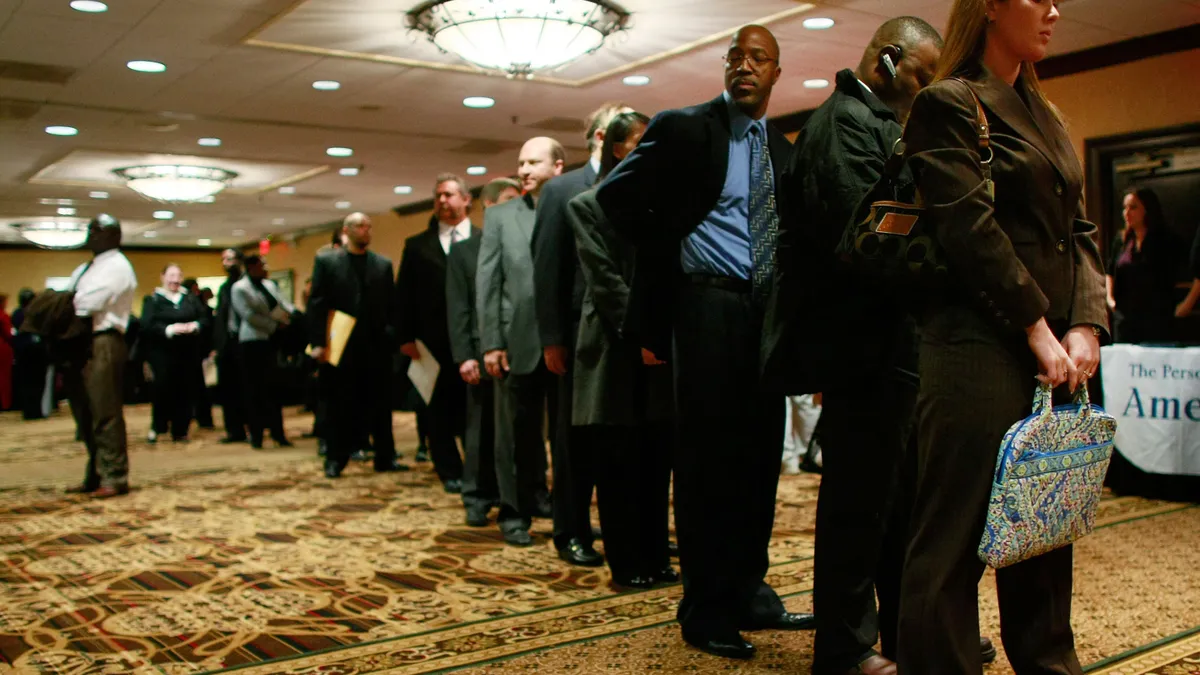Dive Brief:
- The U.S. economy will probably tip into a “brief and shallow” recession from the fourth quarter through the first quarter of 2023 as the Federal Reserve raises borrowing costs to reduce demand and curb the highest inflation in nearly four decades, Conference Board Chief Economist Dana Peterson said Friday.
- “We are expecting recession basically because the Fed is engaging in very restrictive monetary policy to tackle inflation and to return key gauges back to 2% inflation targets,” Peterson said during a webcast.
- The U.S. and Europe face several headwinds, including high inflation, a shrinking labor force, pandemic-induced crimps in supply chains and high commodity and energy prices caused by Russia’s invasion of Ukraine, Peterson said. “Risks are mostly tilted to the downside,” she said, predicting Europe will also suffer a downturn during the next two quarters.
Dive Insight:
The Fed will probably not reduce inflation to its target next year despite its most aggressive pullback in accommodation since the 1980s, Conference Board Principal Economist Erik Lundh said. He predicted the central bank will increase the federal funds rate close to 4% by early 2023.
Even amid high price pressures and rising borrowing costs, consumers last month increased spending by 0.3% in stores, online and in restaurants, exceeding inflation in a rebound from a 0.4% decline in spending during July, the Commerce Department said Thursday.
Early this month consumer sentiment toward the economy brightened a bit, according to a University of Michigan survey released Friday.
“Spending among consumers is holding up more than I think a lot of people have expected, but we’re really concerned about the fourth quarter and first quarter of next year,” Lundh said during the webcast.
Indeed, consumers have grown more pessimistic about long-term prospects for the economy, the University of Michigan said.
CEOs also voice grim predictions about growth, according to results of a survey by the Conference Board and Business Council. Four out of five CEOs (81%) are preparing for a brief, shallow recession during the next 12 to 18 months, with 12% predicting a deep downturn that will harm the global expansion.
Signs of weakness have built up in recent weeks. Industrial production fell 0.2% in August compared with July, largely because of a plunge in utilities output, the Federal Reserve said Thursday.
Rates on a 30-year fixed-rate mortgage exceeded 6% this week for the first time since 2008, Freddie Mac said Thursday, spotlighting the weakening housing market.
Headwinds to growth will eventually soften, Lundh said. After a brief, mild downturn, “the U.S. economy should start to expand again towards the tail half of 2023.”
The job market in recent months has undergirded the economy, with businesses hiring even as the economy shrank during the first half of 2022.
Employers hired 315,000 workers last month, a decline from a gain of 526,000 in July, but better than the hiring pace prior to the pandemic.
Fed Chair Jerome Powell and other policymakers have said in recent months the strong labor market suggests that the expansion may withstand further tightening.
The central bank is trying to reduce demand and bring down price pressures without nudging the economy into recession. The Fed, as mandated by Congress, seeks to maintain low inflation and achieve maximum employment.
“Because of the strong labor market, right now there is no trade-off between the Fed’s employment and inflation objectives, so we will continue to aggressively fight inflation,” Fed Governor Christopher Waller said on Sept. 9.
“I am ready and willing to do what it takes to bring inflation down,” he said in a speech. “Until I see meaningful and persistent moderation of the rise in core prices, I will support taking significant further steps to tighten monetary policy.”
Fed officials plan to meet Sept. 20-21.















